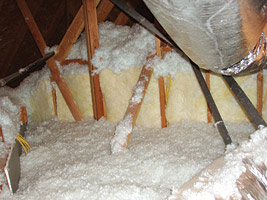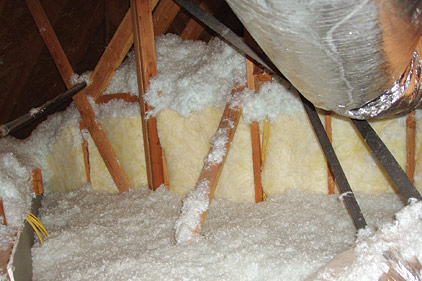
|
| Issues such as wet insulation can mimic the smell of dirty sock syndrome. Condensate pans and drainage are other places to look for any type of biological growth as well. |
Found in both commercial and residential units, dirty sock syndrome can take a state-of-the-art heating and cooling system owner straight to their junior high gym locker days. According to Casey1230, a forum user complaining in May 2011 about the new system he or she had installed, this trip down memory lane wasn’t a pleasant one. The user had an earful ready for the unit’s salesperson and didn’t appear optimistic about the company’s HVAC technician coming to look at the problem the next day.
Casey1230 punctuated the complaint with, “I can’t believe that I spent $10,000 for a new system only to have my house stink.”
Further down the thread, another dirty sock syndrome sufferer, jmarie, let the HVAC contractors who installed her geothermal system have it.
“Our installer was arrogant from the very beginning so it gave us immense pleasure to be able to prove him wrong.”
It seems that not only can dirty sock syndrome cause the customer problems, but it can also damage an HVAC contractor’s reputation. Is there a solution for smelly systems and the stinky reputations they can cause contractors?
Start with the Basics
“Dirty sock syndrome is the combination of slime and mold found on coils and occasionally in the condensate pan,” said Ken Bodwell, operational consultant, Innovative Service Solutions, Orlando, Fla. “It is bacteria that grows on the indoor coil, especially on a heat pump. It is not thought to be hazardous to occupants because it does not become airborne and is only detectable by the unpleasant odor. When the unit switches from heat to cool, the odor is released.”
Bodwell explained that there are different types of equipment affected, and that dirty sock syndrome is not manufacturer-specific. He also noted that coil replacement is not really necessary unless the bacteria is embedded in the coil.
“The problem seems to be limited to heat pumps,” said Leigh MacKenzie, service manager, Sky Heating & Air Conditioning, Portland, Ore. “In most gas-fired furnaces, the coil temperature exceeds 160°F, a temperature that would kill most microbial life. But, in heat pumps, the typical coil temperatures during heating cycles is between 120° and 130°, a temperature that seems ideal for the supposed microorganism to thrive.”
MacKenzie added, “Finding a solution – well, that’s the million dollar question. A lot of things have been tried, and some have worked for a while, but the dirty sock smell seems to find its way back.”
Ensure Correct Diagnosis
Despite the need for regular maintenance and cleaning, Fred Kobie, president and CEO of Kobie Kooling Inc., Fort Meyers, Fla., pointed out that other issues with the HVAC system can mimic dirty sock syndrome.
“Wet insulation is often thought to be dirty sock syndrome,” he said. “The smell is as pungent, but for different reasons.”
MacKenzie noted that in extreme cases, the entire duct system may need to be replaced. “In most cases, these odors and smells are attributed to mold or bacteria in the duct work, which can be eliminated though the installation of a UVC lamp in the return air duct inlet of the furnace. In earlier times, it meant removing the indoor coil of heat pump systems treating the drain pan.”
Preventive Maintenance Solutions
For many HVAC contractors and technicians, cleaning coils tends to eliminate dirty sock syndrome smells and complaints. Once completed, however, Kobie suggests that contractors institute a program of preventive maintenance measures to keep dirty sock syndrome at bay.
“The main cause of dirty sock syndrome is a lack of good preventive maintenance,” he said. “Biannual services should include a chemical cleaning of the evaporator coil and a good antimicrobial agent applied to the coil to help over a longer period of time.”
He explained that UV lights help prevent bacteria and viral growth on a covered surface and noted that photohydroionization (PHI) is an effective method for the treatment and prevention of dirty sock syndrome as well.
“In my experience, there is no better or simpler method than the PHI cell,” said Kobie. “Of course the prevention is predicated on using a properly fitted filter targeted for a customer’s specific environment. Fresh air is also a good preventive measure and lacking in many homes.”
Dirty Sock Patterns
Advances in physical and chemical dirty sock solutions seem to have pushed dirty sock syndrome out of the spotlight. Although still an issue that contractors need to address, many of the contractors interviewed for this article agreed that dirty sock syndrome isn’t as prevalent as it was just a few years ago, and that it could be fully remedied through preventive maintenance regiments and agreements. Is there a solution for smelly systems? Yes. There are many resolutions, and it’s up to a contractor to choose which works best for his business and customers.
Is there a solution for stinky contractor reputations resulting from the mishandling of dirty sock syndrome? Yes. Ensure proper diagnosis, thorough cleaning, customer education, and preventive maintenance agreements. As for Casey1230 and jmarie, let them serve as a cautionary tale of the mishandling of dirty sock syndrome.
SIDEBAR: Three Steps to Stop Dirty Sock Syndrome
1. Properly identify the problem before taking action.
Eliminate dirty drain pans holding water, drain lines connected to plumbing systems without adequate traps or dry traps, return air leaks in ductwork or chases, or dead animals in ductwork or near the living space. If the odor is present all the time, especially during heat, the problem is not a dirty sock syndrome complaint.
2. Thoroughly clean the evaporator coil with a non-acid coil cleaner.
Cleaning will bring the system back to normal and will usually prevent a complaint for the rest of the heating season. Some systems cleaned early in the season, or those having more of a problem, may have repeated problems during the same season.
3. Apply a coating to the coil to prevent further growth. There are multiple types and brands. Consult a local distributor for suggestions.
Don’t initiate step three until the coil is completely dry. Allow the blower to run on fan-only and let it assist in drying the coil faster.
Sidebar information courtesy of Wittichen Supply Co., http://wittichen-supply.com.
Publication date: 11/4/2013
Want more HVAC industry news and information? Join The NEWS on Facebook, Twitter, and LinkedIn today!



Report Abusive Comment